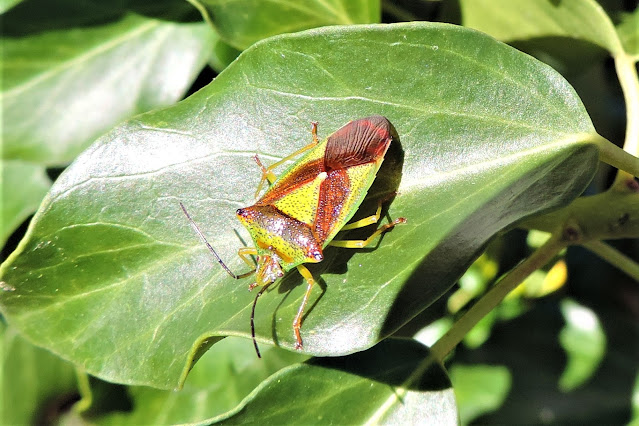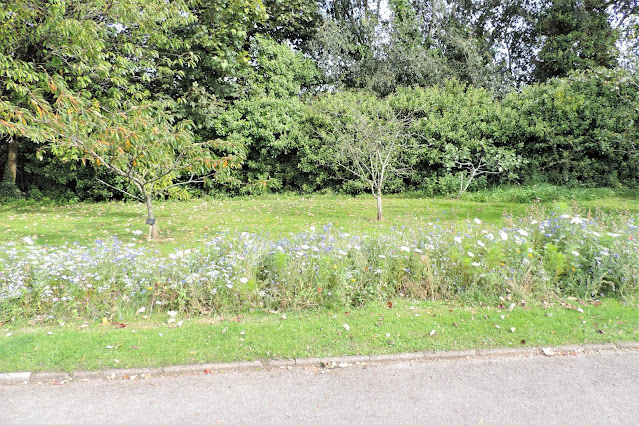Saturday, 31 October 2020
Adelphocornis quadripunctatus
Wednesday, 14 October 2020
Ivy watch
With all the flowers now gone over, it just leaves the Ivy to visit for the dwindling number of hoverflies with the season coming to an end rapidly over the next two weeks until March 2021. The three sites I have been visiting have been Maesteg Welfare Park, Maesteg Cemetery and the Ivy laden trees of Llangynwyd viaduct. Highlights include Sericomyia silentis (4), Melanostoma mellinum (2) and Eupeodes corollae (1). Out of the 15 species seen Episyrphus balteatus (71) was the most numerous. From here on only warm days (15c+) will produce any insects and the Ivy will be gone by the end of the month.
Specimens have been restricted this year to one box (75) and I'll be lucky if I get any new ones to add to the total, fingers crossed.
Sunday, 27 September 2020
Maesteg Welfare Park
The Ivy is just starting to bloom, so there were very few species feeding the best being Volucella pellucens. So I turned my attention back to last weeks flowerbed of White Laceflower, Japanese Anemone and Cornflower. There were a further 14 species feeding there, species new from last week included Melanostoma mellinum (m), Sphaerophoria scripta (m), Cheilosia impressa (m), Rhingia campestris (m) and Syritta pipiens (15). The commonest species was Eristalis tenax (25). Not much else about besides Red Admiral and Speckled Wood butterflies. Although a female Common Darter resting on a Rose flower was unusual.
Monday, 21 September 2020
Sunday
With only a short window, I visited the scabious patch again, it was still going strong with 20 species seen, highlights included Eupeodes latifasciatus (f), Xanthogramma pedissequum (f) and Sericomyia silentis (12). Most numerous species was again Eristalis tenax (55).
A Dock Bug was new for the C.O.P. and 10 Silver Y were feeding on Devilsbit Scabious. 4 species of common butterfly were also present. A singing Garden Warbler in the bungalow trees was a bit of a surprise though.
Saturday, 19 September 2020
Saturday
Fine weather but a strong north easterly wind, meant the 20c temperature felt more like 15c. With most of the flower areas now out of bloom , I payed a short visit to three places to check out whether the Ivy was in bloom.
Maesteg Welfare park
The Ivy here [background of 2nd photo) was yet to open, but the flower bed in front of it had a few ornamental flowers which were attracting hoverflies particularly the ornamental umbellifer Orlaya grandiflora (White Laceflower) and Anemone hupehensis var. jappnicax hybryda (Japanese Anemone). 13 species of hoverfly were recorded in this small one bed, with the commonest being Eristalis arbustorum (6) and Cheilosia scutellata (6).
Maesteg Cemetery
I visited at the wrong time of the day and the Ivy although starting to open was in the shade and I only recorded 8 species with the best being Sericomyia silentis (f).
Lletty Brongu woods
This small Ivy patch over the stream by the farm was very productive, holding 15 species of hoverfly, with Eristalis arbustorum again the commonest (8) species. The best from the woods included Eupeodes luniger (f), Riponnensia splendens (m) and Helophilus pendulus (3).
Between the three sites I also saw the butterflies Comma (1), Red Admiral (4), Small White (2) and Speckled Wood (4). Also 3 Green Shieldbug were seen.
Thursday, 10 September 2020
Devilsbit Scabious patch revisited
Revisited the scabious patch by Newtown Bungalows, Caerau to see what was about. Still in full bloom and lots of insects feeding in the afternoon sunshine.
18 species of hoverfly seen, which is good for the time of year. My first Eupeodes latifasciatus (f) of the year was seen [species number 105 for the year]. Other highlights included a Rhingia rostrata (m) among the campestris present, Helophilus trivittatus (3), Helophilus pendulus (12) and Sericomyia silentis (6). Eristalis tenax (100) was the most numerous again. Also took a Platycheirus as a specimen which keys out to one of the rare ones, but will have to wait until the end of the year when I send my specimens off to Roger Morris of the Hoverfly Recording Scheme. Only downer was my camera battery run out after 12 shots.
Other insects present included good numbers of the migrant moth Silver Y (20) and 5 species of butterfly including Red Admiral. Also seen was the locally scarce Tachinid Fly Nowickia ferox and the Tortoise Shieldbug.
Monday, 31 August 2020
Blaencaerau C.O.P
Last day of the long weekend was spent walking round my local patch. Weather was cloudy most of the time with brief intervals of sunshine. I recorded 22 species of hoverfly in noticeably smaller numbers. Highlights being Eristalis intricaria (m&f), Helophilus trivittatus (2) and Sericomyia silentis (11). Eristalis tenax (48) was the commonest species. Nothing else unusual in the insect world.
Sunday, 30 August 2020
Mynydd Bach (south) SS8691
Although it hit 20c and was largely fine, the day had an autumn feel about it. Lots of the late summer flowers are now going over like Angelica, Hemp Agrimony and Common Fleabane. Wild Carrot is hanging on as is Water Mint and Japanese Knotweed is now blooming, but Ivy is a few weeks away yet. Numbers of hoverflies will start to drop dramatically over the next few weeks and be almost gone by October.
Today I recorded 23 species of hoverfly with highlights being another Rhingia rostrata (f), Volucella pellucens (m & f) and some late Chrysogaster solstitialis (7) on Wild Carrot. Eristalis pertinax (30) was again the commonest species.
6 species of butterfly were seen headed by Red Admiral (4), the only other insect of note was the Tortoise Shieldbug (2).
Saturday, 29 August 2020
Gilfach, Top Llangynwyd
Weather was a bit hit and miss today, with sunny periods interspersed with dark cloud at times but thankfully no rain. The temperature was noticeably cooler (15c) in the stiff south westerly breeze. It was hard going at times but I did manage to record a healthy 26 species of hoverfly. Highlights being a too brief to photograph Eriozona syrphoides (f), Rhingia rostrata (f) and Helophilus trivittatus (2f) that seems to be having a good second brood. Eristalis pertinax (60) was the most numerous.
Other notable insects included another 3 of the micro moth Phaulernis fulviguttella and the butterfly Small Copper. Also new for the valley was the Sycamore white-spot fungus (Cristulariella depraedans).
Friday, 28 August 2020
Devilsbit Scabious patch now in full bloom
At the end of August the Devilsbit Scabious comes into bloom at the river bank opposite Newtown bungalows and is usually good for hoverflies for a couple of weeks. But on Wednesday it was in fine form with it being sunny and warm in the afternoon after morning rain. 16 species of hoverfly were recorded just on this plant a full list below.
Platycheirus albimanus (5)
Tuesday, 11 August 2020
Blaencaerau - Sunday
Another warm day of dipping hat in river to cool me down. 28 species of hoverfly recorded, best were Platycheirus rosarum (f), Scaeva pyrastri (4), Cheilosia bergenstammi (first of summer brood), Xanthogramma pedissequum (3m) and Sericomyia silentis (m). Eristalis numbers building nicely with pertinax (60) the most numerous.
Other stuff seen included a very late Dark Green Fritillary and the gall mite Acalitus brevitarsus on Alder which was new for the valley and the Dark Giant Horsefly, which was a beast.
Dark Giant Horsefly
Saturday, 8 August 2020
Back to Top Llangynwyd after covid scare
Last Thursday (30th July) I woke up in the middle of the night with a high fever a burning hacking cough and I lost my voice briefly. I managed to phone work who told me not to come in until I had a covid-19 test. Luckily on Tuesday I had a negative test result after self-isolating and returned to work this Thursday (5th August). I spoke to the company boss and the scenario of what would have happened if I had tested positive. He said the company would immediately close and everyone in the factory would have to have a test before returning to work, a specialist company would have to come in to deep clean the workplace and the company would lose £100,000 pound a day - so no pressure there then. My brief illness was diagnosed as a sinus infection and was gone in 48 hours.
So back in the free world today I visited Gilfach, Top Llangynwyd which is particularly good at this time of year for hoverflies, with lots of flowers in bloom including large beds of Hogweed, Angelica, Creeping Thistle, Hedge Woundwort, Common Fleabane, Herb Robert, Oxford Ragwort and a few Buddleah bushes. Even though it was 30c I recorded 28 species of hoverfly. Pipizella viduata, Platycheirus manicatus and Helophilus hybridus were new for the year taking me to 102 for the year. Lots of good hoverflies included Dasysyrphus albostriatus, Parasyrphus lineola, Xanthogramma pedissequum, Riponnensia splendens and Helophilus pendulus. Lots of Eristalis about today with pertinax (80) the most numerous.
Lots of butterflies about with Small Tortoiseshell (20) the highest numbered species. A few 6-spot Burnets were still on the wing and more interesting flies included Nowicka ferox (Tachinid), 19 Phasia hemiptera (Tachinid) and Physocephala rufipes (Conopid).
6-spot Burnet (moth)


















































